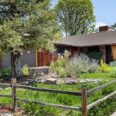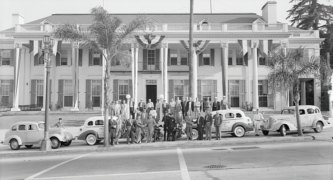
“It is a beautiful building. It’s an anchor in that part of our city and those of you who’ve not visited the building really should take this time to visit it. It really is a beautiful structure,” said Mayor Victor Gordo during the November 18 Council meeting.
The irregularly-shaped property, with frontages along West Colorado Boulevard, South Orange Grove Boulevard, West Green Street, and Terrace Drive, presents the Lodge building at its northeasterly portion, with the majority of the site utilized as paved surface parking on the western side.
The parking lot is arguably as famous as the Lodge; “TV Corner,” as it’s known, is the site where broadcast and streaming video feed operations for the Rose Parade set up camp at New Year’s.
A Montessori School, operating under a land lease separate from Lodge operations, occupies the southeast corner.
The landmark designation recognizes the building’s architectural significance under Criterion C of the Pasadena Municipal Code, as it embodies distinctive characteristics of the Neoclassical Revival style and represents the work of prominent architect Myron Hunt, who died in 1952.
Hunt, who received Pasadena’s Arthur Noble Medal in 1928, designed other notable local landmarks including the Huntington Library, Rose Bowl, Pasadena Central Library, Huntington Hospital, and buildings at California Institute of Technology and Occidental College.
Character-defining features include a symmetrical front facade, centralized full-height projecting front porch spanning nearly the full width, rounded Tuscan columns with Doric capitals, wooden shutters, and double-hung wood windows. The building includes several intermediate floor levels, a basement, and a full-height attic space with dormer windows. A third-floor terrace at the flat roof features iron railing, and the structure showcases an entablature with a simple architrave and frieze with dentil cornice.
A ballroom addition was constructed in 1928, designed by architects Cyril Bennett and Fitch Haskell, who also designed the Pasadena Masonic Temple, Raymond Theatre, and Pasadena Civic Auditorium. The building has maintained significant architectural integrity through its location, design, materials, workmanship and feeling, with minimal exterior alterations since construction.
The Pasadena chapter of the Benevolent Protective Order of Elks was established in 1908 and commissioned Hunt to design their clubhouse.
The designation process included extensive public notice, with 152 postcards mailed, 55 notices posted, and one letter of support received. The action was found to be categorically exempt from California Environmental Quality Act review.














 0 comments
0 comments



